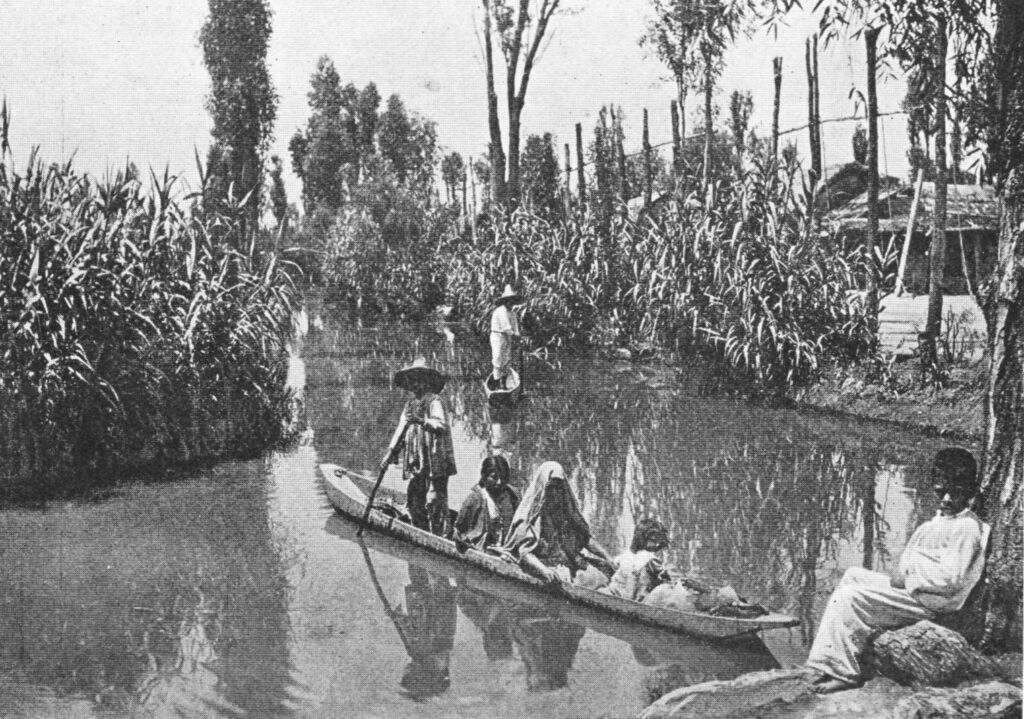For thousands of years before the arrival of the nomadic Aztecs, other tribes, including the Olmecs and Toltecs, inhabited the Valley of Mexico in what is now Mexico City.
The already-established neighbors of the Aztecs were sitting on arable land filled with nutrient-rich soil, leaving the Aztecs with less desirable land. To create a successful food supply for the large Aztec civilization, the tribe needed to become innovative farmers.
After much problem-solving and experimentation, the Aztecs perfected the building of artificial islands, or chinampas, made of reeds and stalks on nearby Lake Texcoco. These “floating gardens” were nicknamed as such because of the ingenious engineering of the Aztecs.
Creating a system of collecting soil from the bottom of the shallow lake, the Aztecs acquired soil that was full of organic debris, and therefore contained high amounts of nutrients. Piling the debris onto these rectangular islands, the Aztecs created the basis for their pioneering system of agriculture.

Perfecting the Practice
Woven reed walls would support the perimeter of the chinampas, while stakes at the corners would sink into the mud in the shallow waters below, keeping their floating crops from drifting away.
To protect the integrity of the chinampas, a type of willow or cypress tree was planted at each corner as well. Yes, even trees flourished in these floating gardens!
With a constant source of water underneath these gardens, the roots of plants would grow through the layer of organic debris and down to their water source.
These smaller chinampas were sometimes joined together to form larger islands, some being as long as two hundred feet. Some of the larger collections of chinampas even had a small hut to house a gardener, continuously present to tend to the crops.
The Aztecs supplied their civilization with many crops, including beans, peppers, squash, maize, tomatoes, and even flowers. All of these plants were very important to the Aztec diet. On market days, towing the gardens closer to shore was convenient to supply items directly to shoppers.
A drainage system was created to facilitate the movement of water. Any collection of mud and debris was dug up and used as fertilizer on top of the chinampa beds.
This kept the crop’s soil consistently rich in nutrients. Channels were left open for canoes to travel through chinampas when harvest time arrived, which happened multiple times per year.
Uniting an Empire
Their sophisticated farming system was not the only aspect of the Aztec Empire that led them to flourish. The powerful Aztec Empire grew in the 15th and early 16th centuries. Eventually, the sheer size of the Empire meant power.
In 1428, Itzcoatl, the first emperor of the Aztec Empire, allied his city of Tenochtitlan and the two neighboring states of Texcoco and Tlacopan.
This great alliance became the power of central Mexico, and by 1519, nearly 6,000,000 people were spread over an 80,000 square mile area. The Aztecs were master builders, shown in the architecture of their city buildings and pyramids.
Their religious beliefs aligned with many other Mesoamerican groups, such as the Maya, and they also created their own calendar and number system.
They practiced a 13th-century version of modern Western courts with judges and varying levels of government leading up to a higher court. Their military system played a key role in their socioeconomic system. A strong and dedicated army kept neighboring cities at bay.
Warfare was viewed as both necessary and a part of their religion – a way to perform a service to their sacred gods. The Empire is truly regarded as one of the greatest ancient civilizations in history.
In the year 1519, everything began to change for the centuries old wandering nomads who had created a remarkable empire. Eager to appropriate new lands in the name of the Spanish crown, Spain-born explorer Hernán Cortéz arrived in Mexico in February of 1519 and by November had conquered a number of Mexican states.
This is when he set his sights on the ultimate prize: the Aztec Empire. In what was known as the Battle of Otumba in 1520, Cortéz was able to take control of the central city of Tenochtitlan.
The Aztec Empire had fallen. Unfortunately, it was during this period of time that the Spanish began draining the lakes containing their chinampas, preferring to create more dry land for agriculture eventually.
Chinampas Today – An Opportunity for Sustainability
Today, the efficient and resourceful practice of chinampa farming still exists in Xochimilco, in the southern portion of Mexico City. Chinamperos use modern-day flat-bottomed boats to travel to and from their floating gardens.
Around 5,000 acres of chinampas still exist, but only a very small percentage is used for farming practices. Much of what exists is used as tourist locations.
Many locals still believe that the innovative chinampa practice could and should be a more widely used farming practice in today’s world. The practice, worthy of protection in regard to the land and its history, could be a sustainable farming practice in locations all over the world. Many believe that sustainable urban farming could be a successful reality when using innovation from centuries past.
Historical Legacy
The Aztec became so much more than “wandering nomads,” and historians agree that what they accomplished was quite a feat. They were resourceful. They indeed created the smartest system for feeding their people.
Chinampas utilized the space they had in a most ingenious way, which led to the expansion of their population.
Chinampas yielded a very high number of crops and left land open for the Aztecs to build homes and create their commanding city. The chinampas are regarded as one of the most successful legacies left by the ancient Aztecs before their downfall to new world explorers.
References:
National Geographic
The Archeologist – Civilizations Around the World

